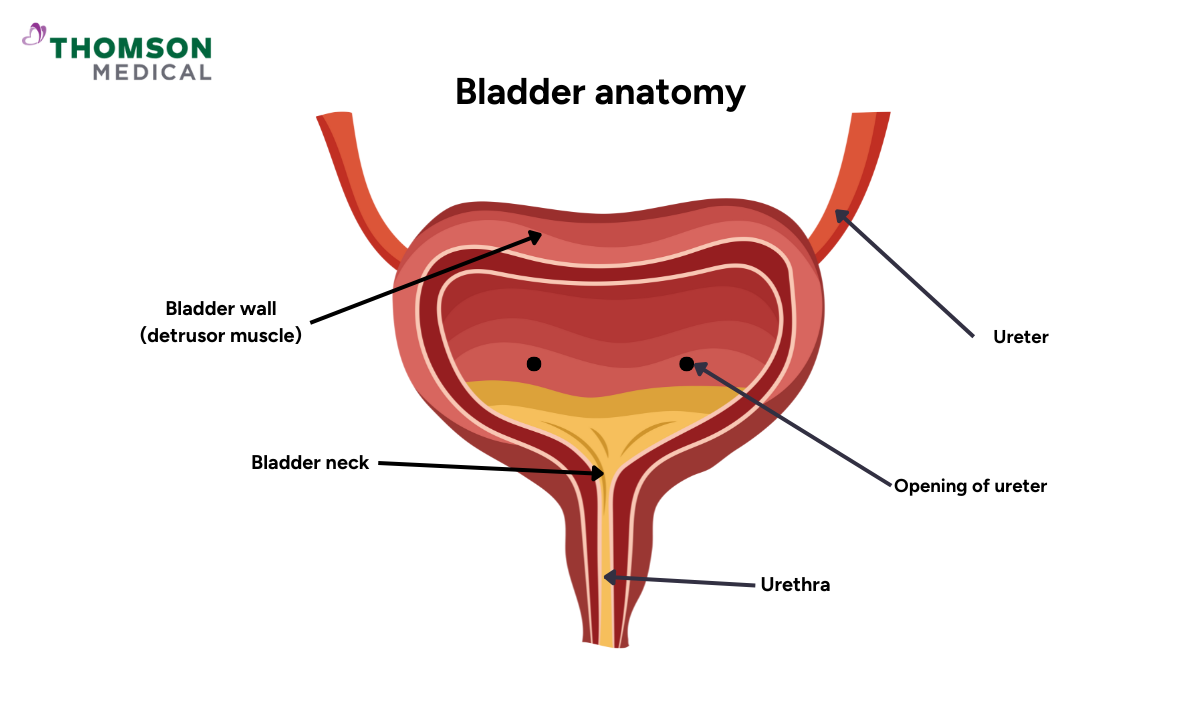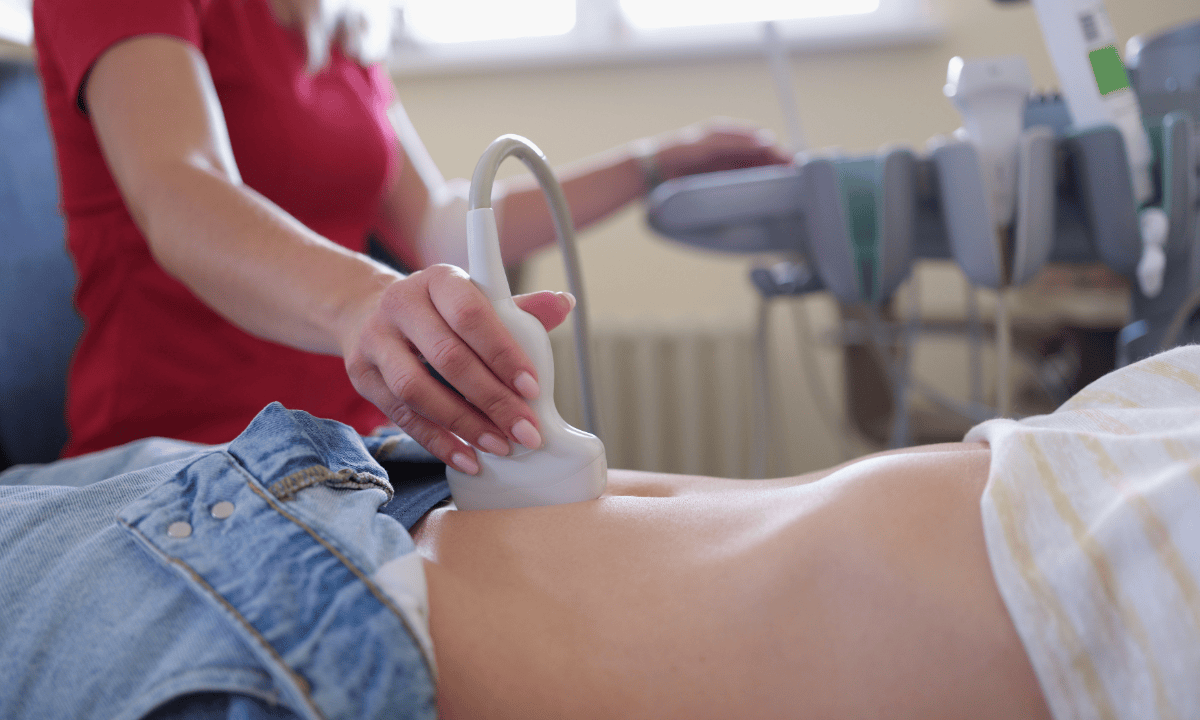What is a bladder ultrasound?
A bladder ultrasound is a non-invasive imaging test that uses high-frequency sound waves to produce detailed images of the bladder. It helps your healthcare provider to assess the overall health of the bladder, including its size, shape, and how well it's retaining and emptying urine.
In Singapore, bladder ultrasound is widely available and can be done at private clinics, polyclinics, or hospitals. It can be done as part of a general health screening or as a stand-alone test to diagnose specific bladder health conditions.
Check our website to find out more about our health screening services and how they can benefit you.
What conditions does a bladder ultrasound detect?

Since a bladder ultrasound is able to produce detailed images of the bladder and the surrounding tissue, it can provide your doctor with insights about various conditions that affect bladder health, such as:
Abnormal bladder size and shape
Any changes to the size and shape of the bladder, such as unusual enlargement or irregular shapes, may indicate health issues like urinary incontinence.
Urine capacity
This imaging test shows how much urine the bladder can hold when it’s full and whether it's completely empty after urination.
Residual urine
A bladder ultrasound can assess how much urine remains in the bladder after you urinate. A high residual urine volume can indicate issues such as weak bladder muscles or nerve-related bladder dysfunction.
Bladder wall thickness
An ultrasound test can measure the thickness of your bladder wall. Thickening can suggest chronic inflammation, infection, or bladder neck obstruction, which reduces or stops the flow of urine into the urethra.
Bladder stones
Ultrasound imaging can detect bladder stones, which are small mineral deposits that can cause pain, difficulty urinating, or increased urinary frequency.
By analysing the results from a bladder ultrasound scan, your healthcare provider can accurately assess your condition and determine the most appropriate treatment options to prevent the disease from progressing to more severe stages.
When do I need this test?
Your healthcare provider may recommend a bladder ultrasound scan if you're showing symptoms associated with bladder problems, such as:
Urinary retention, which occurs when your bladder doesn't empty completely after you urinate, making you feel like you still have to go to the toilet.
Frequent urination, where you feel the need to urinate more often than normal.
Painful urination, a feeling of discomfort, and a burning sensation when you urinate.
Difficulty urinating, where you're having trouble initiating urination or have a weak urine stream.
Experiencing recurring bladder infections, such as urinary tract infections (UTIs) or chronic bladder infections.
If you are experiencing any of the mentioned symptoms, request an appointment with Thomson Medical. Our specialists can assist with further diagnosis, including a bladder ultrasound scan, to determine the cause of your symptoms and provide an appropriate treatment plan.
How does it work
A bladder scan works by using high-frequency sound waves that are emitted from a handheld device called an ultrasound probe or transducer. During the procedure, an ultrasound technician (sonographer) will apply a clear gel that helps the transducer to glide smoothly to the skin below your belly button (the pelvic area).
For this test to be effective, you'll need to have a full bladder. It allows the sonographer to measure the bladder volume and evaluate how well your bladder retains and empties urine.
Additionally, a full bladder helps produce better images by pushing aside other organs, such as the bowels, and creating a clearer pathway for the sound waves, which travel more effectively through fluids.
As the sonographer gently moves the probe over your pelvic area, sound waves bounce off the bladder and other tissue around it and return to the probe at varying speeds. These reflected sound waves are then converted by a computer into real-time images (sonograms) that can be displayed on a screen for assessment.
What to prepare before a bladder ultrasound

A bladder ultrasound scan is a straightforward and non-invasive procedure. However, there are a few things you need to prepare for prior to the scan, such as:
Drink about 750–1000 mL of water at least 1 hour before the test and refrain from urinating to ensure your bladder is full.
Wear loose and comfortable clothing, as you will need to lift your shirt so that the sonographer can examine your pelvic area.
Additionally, remove any jewellery or items that might interfere with the scan.
During the procedure
Once you’ve completed the preparation steps, the procedure will begin. Here’s what you can expect during the bladder scan:
You'll be asked to lift your shirt up to your chest or undress from the waist up.
Afterwards, you will lie on your back on the examination table, and the sonographer will apply a clear gel to your pelvic area.
The transducer is then gently pressed against your skin and moved between your belly button and pubic bone to examine the entire bladder.
The device will then transmit detailed images of the bladder in real-time so you and your healthcare provider can observe them on-screen during the scan.
After taking the first scan with a full bladder, the sonographer then will ask you to use the restroom before continuing scanning your bladder. During this round, they'll measure the amount of pee left in your bladder after you urinate.
After the ultrasound is completed, the sonographer will wipe away any remaining gel from your skin.
After the scan is finished, the sonographer will send the results to a radiologist, a specialist in medical imaging, for analysis. Once the radiologist has reviewed the images, they will share their findings with your doctor.
Your healthcare provider will then contact you for a follow-up appointment to discuss any important findings, possible abnormalities, and suggested next steps based on the evaluation. This procedure is quick and painless, typically lasting between 15 and 30 minutes, allowing you to return to your regular activities right after the scan.
Always follow preparation guidelines and discuss any concerns with your doctor to ensure the most accurate results. Request an appointment with Thomson Medical to find out if a bladder ultrasound is the right imaging test for you.
Bladder ultrasound costs in Singapore
In Singapore, a bladder ultrasound can be performed at a hospital, clinic, or diagnostic centre. The cost of this imaging test depends on whether it's performed as a standalone test or as part of a health screening package, as well as the choice of medical facility.
To help cover the cost, you can use up to SGD 300 annually from your MediSave account at select clinics. If you have private insurance, you may need to check with your individual provider to see if a bladder ultrasound is covered by your policy.
For detailed fee information and payment options, please consult your healthcare provider directly. Request an appointment with our specialists at Thomson Medical today for a detailed price breakdown and a personalised care plan.
Are there any side effects from a bladder ultrasound?
A bladder ultrasound is a safe procedure because it doesn't use ionising radiation, unlike X-rays and CT scans. However, you might experience some mild discomfort, such as:
Discomfort from having a full bladder during the procedure.
Slight discomfort from lying on the examination table.
If the sonographer needs to apply pressure to your pelvis to get clear images, this can feel uncomfortable.
Slight pressure from the transducer on the abdomen.
In rare cases, the gel applied to your skin may cause a mild skin irritation, but this condition is uncommon and usually resolves quickly after the procedure.
FAQ
What does a bladder ultrasound show?
A bladder ultrasound produces detailed images that show:
The size and shape of your bladder
Bladder wall thickness (which may indicate inflammation or obstruction)
Urine capacity (how much urine your bladder can hold)
Residual urine (the amount of urine left in the bladder after urination)
Presence of bladder stones or other abnormalities
Do I need to have a full bladder before doing a bladder ultrasound?
Yes, a full bladder is necessary for a bladder ultrasound. You'll usually be instructed to drink approximately 750 to 1000 mL of water at least 1 hour before the test and refrain from urinating until after the scan.
A full bladder improves image quality by pushing aside surrounding organs and creating a clearer pathway for the sound waves. It also allows the sonographer to measure bladder volume accurately and evaluate how well your bladder retains and empties urine.
Can a bladder ultrasound detect an infection?
A bladder ultrasound is not specifically designed to diagnose infections, but it can show changes that may suggest infection, such as:
Bladder wall thickening, which could be a sign of chronic inflammation or infection.
Urinary retention, which could increase the risk of bladder infections if the bladder isn’t emptying properly.
Bladder stones, which could cause or contribute to bladder infections.
For a definitive diagnosis of a bladder infection, your doctor will typically require additional tests such as a urine analysis or culture to identify bacterial presence. The ultrasound is most valuable for assessing bladder structure and function rather than confirming infections.
What are the five warning signs of a bladder infection?
The 5 warning signs of a bladder infection (also known as a urinary tract infection or UTI) include:
Painful or burning sensation while urinating
Frequent urge to urinate
Cloudy or foul-smelling urine
Pelvic discomfort or pain
Blood in the urine
How long does a bladder ultrasound take?
A bladder ultrasound usually takes between 15 and 30 minutes. The procedure is quick and non-invasive. The time may vary depending on the complexity of the images needed or if additional views are required, but it is generally a fast and simple test.
The information provided is intended for general guidance only and should not be considered medical advice. For personalised recommendations based on your medical conditions, request an appointment with Thomson Medical.
For more information, contact us:
Thomson Specialists Paragon (Health Screening)
- Mon - Fri: 8.30am - 5.30pm
- Sat: 8.30am - 12.30pm
Call: 6735 0300
Request a Health Screening